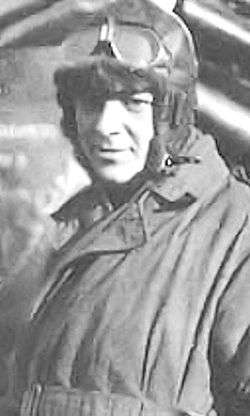Sydney MacGillvary Brown
| Sydney MacGillvary Brown | |
|---|---|
|
Sydney M. Brown in 1918 | |
| Born |
10 August 1895 Marblehead, Massachusetts, United States |
| Died |
7 April 1952 (aged 56) Pittsburgh, Pennsylvania, USA |
| Allegiance |
United Kingdom United States |
| Service/branch |
Royal Air Force United States Navy |
| Years of service |
1917–1918 1942–1945 |
| Rank |
Lieutenant (RAF) Lieutenant-Commander (USN) |
| Unit | No. 29 Squadron RAF |
| Battles/wars |
World War I World War II |
| Awards |
Distinguished Flying Cross Croix de Guerre (France) |
| Other work | Author and professor of medieval history |
Sydney MacGillvary Brown DFC (10 August 1895 – 7 April 1952) was an American World War I flying ace, who later became an author and professor of medieval history.[1]
Biography
Brown was born in Marblehead, Massachusetts, and attended Bowdoin College in Brunswick, Maine, where he was member of the Phi Beta Kappa Society.[2] He graduated in 1916, delivering an address at the commencement ceremony.[3]
World War I
Brown joined the Royal Flying Corps in July 1917,[4] and was appointed a temporary second lieutenant (on probation) on 12 January 1918.[1] On 4 July 1918, he was assigned to No. 29 Squadron, flying the SE.5a. He destroyed a Fokker D.VII on 12 August 1918, a DFW reconnaissance plane on the 19th, another Fokker D.VII on 28 September, an observation balloon on 27 October 1918, and a third D.VII on the 28th.[4] In February 1919 he was awarded the Distinguished Flying Cross. His citation read:
Second Lieutenant Sydney MacGillvary Brown.
- On 28 October, when on offensive patrol, this officer, in company with three other machines, attacked nine Fokkers; three of the latter were destroyed, 2nd Lieut. Brown accounting for one. In addition, he has three hostile aircraft and one balloon to his credit. He is a fearless and intrepid officer.[5]
Later career
Brown returned to his academic career after the war, attending Oxford University.[1] In 1922 he was appointed Assistant Professor of History and Political Science at Lehigh University, Bethlehem, Pennsylvania,[6] where he taught for the next twenty years.[2] Brown was awarded a Master of Arts degree by Oxford in 1927, and received his Ph.D in 1937.[7]
During World War II Brown served in the United States Navy Reserve as an aerial navigation officer[1] in Britain and Italy,[2] with the rank of lieutenant-commander.[1]
In 1947 he was appointed an associate professor of medieval history at Duquesne University, Pittsburgh. He died on 7 April 1952 at the Mercy Hospital in Pittsburgh.[1]
Publications
- Brown, Sydney M. (1927). Mazzini and Dante. New York: The Academy of Political Science.
- Brown, Sydney M.; Coulton, G. G. (1928). "Five Centuries of Religion". American Historical Review. 33 (3).
- Brown, Sydney M.; Coulton, G. G.; Wilson, J. Dover; Hartridge, R. A. R. (1931). "A History of Vicarages in the Middle Ages". American Historical Review. 36 (4).
- Brown, Sydney M. (1932). Medieval Europe. New York: Harcourt, Brace.
- Odo Rigaldus, Archbishop of Rouen (1964). O'Sullivan, Jeremiah Francis, ed. The register of Eudes of Rouen. Brown, Sydney M. (trans.). New York & London: Columbia University Press.
See also
References
- Notes
- 1 2 3 4 5 6 "Sydney Brown". The Aerodrome. 2014. Retrieved 23 September 2014.
- 1 2 3 "Duquesne U. Professor Dies; Noted Historian". The Aerodrome. 10 April 1952. Retrieved 23 September 2014.
- ↑ "Bowdoin Commencement Speakers". George J. Mitchell Department of Special Collections & Archives. 2014. Retrieved 23 September 2014.
- 1 2 Shores et.al. (1997), p.90.
- ↑ The London Gazette: no. 31170. p. 2036. 7 February 1919.
- ↑ "History of Lehigh University 1864-1993" (PDF). Lehigh University. 2014. Retrieved 23 September 2014.
- ↑ The Duquesne University Bulletin. XL. January 1952. p. 8. Retrieved 23 September 2014.
- Bibliography
- Shores, Christopher F.; Franks, Norman; Guest, Russell (1990). Above the Trenches: A Complete Record of the Fighter Aces and Units of the British Empire Air Forces 1915–1920. London, UK: Grub Street. ISBN 0-948817-19-4.
